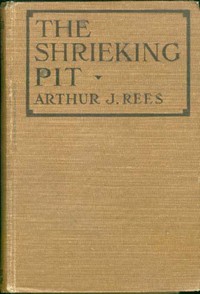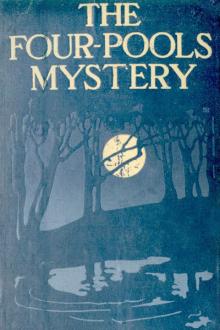The Shrieking Pit, Arthur J. Rees [reader novel .TXT] 📗

- Author: Arthur J. Rees
Book online «The Shrieking Pit, Arthur J. Rees [reader novel .TXT] 📗». Author Arthur J. Rees
"There are two or three points in this case which I am unable to clear up to my complete satisfaction. Why did Benson leave the key in the outside of the door? Was it merely one of those mistakes—those oversights—which all murderers are liable to commit, or did he do it deliberately, in the hope of conveying the impression that Mr. Glenthorpe had gone out and left the key in the outside of the door. In the next place, I cannot account for the mark of the box underneath the window. There is a third point—the direction of the wound in the murdered man's body, which gave me some ideas at the time that I am now compelled to dismiss as erroneous. But these are points that I hope will be cleared up by Benson's arrest, and confession, for I am convinced, by my observation of the man, that he will confess.
"There are one or two more points. Benson is an ardent fisherman, who spends all his spare time fishing on the marshes. The stolen pocket-book was suspended in the pit by a piece of fishing line. But I attach more importance to the second point, which is that since the murder has been committed the nightly conversation at the inn tap-room has centred around a local ghost, known as the White Lady of the Shrieking Pit, who is supposed from time immemorial to have haunted the[Pg 313] pit where the body was thrown, and to bring death to anybody who encounters her at night. This spectre, which is profoundly believed in by the villagers, had not been seen for at least two years before the murder, but she made a reappearance a night or two after the crime, and is supposed to have been seen frequently ever since. It looks to me as though Benson set the story going again in order to keep the credulous villagers away from the pit where the money was concealed.
"This morning, in company with Mr. Oakham, I saw Penreath in the gaol, and by a ruse induced him to break his stubborn silence. His story, which it is not necessary for me to give you in detail, testifies to his innocence, and supports my own theory of the crime. He did not see the murder committed, but he saw the girl go into the room, and subsequently he saw her father enter and remove the body. It was the latter spectacle that robbed him of any lingering doubts he may have had of the girl's guilt, and forced him to the conclusion that she and her father were accomplices in the crime. But he loved her so much that he determined to keep silence and shield her."[Pg 314]
CHAPTER XXVI"This is a remarkable story, Mr. Colwyn," said the chief constable, breaking the rather lengthy silence which followed the conclusion of the detective's reconstruction of the crime. "It has been quite entrancing to listen to your syllogistical skill. You would have made an excellent Crown Prosecutor." The chief constable's official mind could conceive no higher compliment. "Your statements seem almost too incredible for belief, but undoubtedly you have made out a case for the further investigation of this crime. What do you think, Galloway?"
"The question, to my mind, is what Mr. Colwyn's discoveries really represent," replied Galloway. "He has built up a very ingenious and plausible reconstruction, but let us discard mere theory, and stick to the facts. What do they amount to? Apart from Penreath's statement in the gaol that he saw the body carried down stairs——"
"You can leave that out of the question," said the detective curtly. "My reconstruction of the crime is independent of Penreath's testimony, which is open to the objection that it should have been made before."
"Exactly what I was going to point out," rejoined Galloway bluntly. "Well, then, let us examine the fresh facts. There are five as I see them. The recovery of Penreath's match-box, the discovery of the door between the two rooms, the wound on the innkeeper's forehead, the additional key, and the finding of the pocket-book[Pg 315] in the pit. Exclude the idea of conspiracy, and the recovery of the match-box becomes an additional point against Penreath, because it strikes me as guess work to assume that he had no other matches in his possession except that particular box and the loose one he found in his vest pocket. Smokers frequently carry two or three boxes of matches. The discovery of the hidden door is interesting, but has no direct bearing on the crime. The wound on the innkeeper's head looks suspicious, but there is no proof that it was caused by his knocking his head against the gas globe in the murdered man's room on the night of the murder. As Mr. Colwyn himself has pointed out, there is not much in Benson having a second key of Glenthorpe's room. Many hotel-keepers and innkeepers keep duplicate keys of bedrooms. The significance of this discovery is that Benson kept silence about the existence of this key. Undoubtedly he should have told us about it, but I am not prepared to accept, offhand, that his silence was the silence of a guilty man. He may have kept silence regarding it through a foolish fear of directing suspicion to himself. That theory seems to me quite as probable as Mr. Colwyn's theory. There remains the recovery of the money in the pit. In considering that point I find it impossible to overlook that Penreath returned to the wood after making his escape. That suggests, to my mind, that he hid the money in the pit himself, and took the risk of returning in order to regain possession of it."
"You are worthier of the chief constable's compliment than I, my dear Galloway," said Colwyn genially. "Your gift of overcoming points which tell against you by ignoring them, and your careful avoidance of telltale inferences, would make you an ideal Crown Prosecutor."
"I don't believe in inferences in crime," replied Gallo[Pg 316]way, flushing under the detective's sarcasm. "I am a plain man, and I like to stick to facts."
"What was the whole of your case against Penreath but a series of inferences?" retorted Colwyn. "Circumstantial evidence, and the circumstances on which you depended in this case, were never fully established. Furthermore, your facts were not consistent with your original hypothesis, and had to be altered when the case went to trial. Now that I have discovered other facts and inferences which are consistent with another hypothesis, you strive to shut your eyes to them, or draw wrong conclusions from them. Your suggestion that Penreath must have hidden the money in the pit because he was arrested near it is a choice example of false deduction based on the wrong premise that Penreath hid the money there on the night of the murder. He could not have done so because he had no rope, and how was he, a stranger to the place, to know that the inside of the pit was covered with creeping plants of sufficient strength to bear a man's weight? The choice of the pit as a hiding place for the money argues an intimate local knowledge."
"You have not yet told us how you came to deduce that the money was in the pit," said Mr. Cromering, who had been examining the pocket-book and money.
"While I was examining the mouth of the pit the previous afternoon I found this piece of paper at the brink, trodden into the clay. Later on I recognised the peculiar watermark of waving lines as the Government watermark in the first issue of Treasury war notes. From that I deduced that the money was hidden in the pit. It was all in Treasury notes, as you see."
"I'm afraid I don't quite follow you now," said the chief constable, with a puzzled glance at the piece of[Pg 317] dirty paper in his hand. "This piece of paper is not a Treasury note."
"Not now, perhaps, but it was once," said the detective with a smile. "It puzzled me at first. I could not account for the Treasury watermark, designed to prevent forgery of the notes, appearing on a piece of blank paper. Then it came to me. The first issue of Treasury notes were very badly printed. Ordinary black ink was used, which would disappear if the note was immersed in water. It was an official at Somerset House who told me this. He informed me that they had several cases of munition workers who, after being paid in Treasury notes, had put them into the pockets of their overalls, and forgotten about them until the overalls came back from the wash with every vestige of printing washed out from the notes, leaving nothing but the watermarks. It occurred to me that the same thing had happened in this case. The murderer, when about to descend to the pit to conceal the money, had accidentally dropped a note and trodden it underfoot, and it had lain out in the open exposed to heavy rains and dew until every scrap of printing was obliterated."
"By Jove, that's





Comments (0)